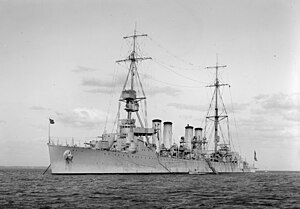
USS New York (BB-34) was a United States Navy battleship, the lead ship of her class. Named for New York State, she was designed as the first ship to carry the 14-inch (356 mm)/45-caliber gun.

USS Mississippi (BB-41/AG-128), the second of three members of the New Mexico class of battleship, was the third ship of the United States Navy named in honor of the 20th state. The ship was built at the Newport News Shipbuilding Company of Newport News, Virginia, from her keel laying in April 1915, her launching in January 1917, and her commissioning in December that year. She was armed with a battery of twelve 14-inch (356 mm) guns in four three-gun turrets, and was protected by heavy armor plate, with her main belt armor being 13.5 inches (343 mm) thick.

The heavy cruiser was a type of cruiser, a naval warship designed for long range and high speed, armed generally with naval guns of roughly 203 mm (8 inches) in caliber, whose design parameters were dictated by the Washington Naval Treaty of 1922 and the London Naval Treaty of 1930. The heavy cruiser is part of a lineage of ship design from 1915 through the early 1950s, although the term "heavy cruiser" only came into formal use in 1930. The heavy cruiser's immediate precursors were the light cruiser designs of the 1900s and 1910s, rather than the armored cruisers of the years before 1905. When the armored cruiser was supplanted by the battlecruiser, an intermediate ship type between this and the light cruiser was found to be needed—one larger and more powerful than the light cruisers of a potential enemy but not as large and expensive as the battlecruiser so as to be built in sufficient numbers to protect merchant ships and serve in a number of combat theaters.

The first USS Newark (C-1) was a United States Navy protected cruiser, the eighth protected cruiser launched by the United States. In design, she succeeded the "ABC" cruisers Atlanta, Boston, and Chicago with better protection, higher speed, and a uniform 6-inch gun armament. Four additional protected cruisers were launched for the USN prior to Newark.
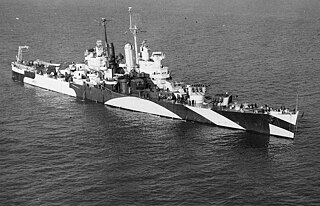
USS Houston (CL-81), was a Cleveland-class light cruiser and the third vessel in the United States Navy named after Houston, Texas. She was active in the Pacific War and survived two separate aerial torpedo hits in October 1944.

Hiei (比叡) was a warship of the Imperial Japanese Navy during World War I and World War II. Designed by British naval architect George Thurston, she was the second launched of four Kongō-class battlecruisers, among the most heavily armed ships in any navy when built. Laid down in 1911 at the Yokosuka Naval Arsenal, Hiei was formally commissioned in 1914. She patrolled off the Chinese coast on several occasions during World War I, and helped with rescue efforts following the 1923 Great Kantō earthquake.

The Atlanta-class cruisers were eight United States Navy light cruisers which were designed as fast scout cruisers or flotilla leaders but which proved to be effective anti-aircraft cruisers during World War II. They were also known as the Atlanta-Oakland class. The Atlanta class had 12 x 5-inch (127 mm)/38 caliber guns, mounted in three superfiring sets of two-gun turrets fore and three more aft. The first four ships of the class also had an additional two twin 5-inch/38 mounts, one port and one starboard, giving these first four Atlanta-class cruisers the heaviest anti-aircraft armament of any cruiser of World War II. The last four ships of the class, starting with Oakland, had slightly different armament as they were further optimized for anti-aircraft fire.

USS Marblehead (CL-12) was an Omaha-class light cruiser, originally classified as a scout cruiser, of the United States Navy. She was the third Navy ship named for the town of Marblehead, Massachusetts.

USS Omaha (CL-4) was the lead ship of the Omaha-class light cruiser of the United States Navy. She was originally classified as a scout cruiser. She was the second US Navy ship named for the city of Omaha, Nebraska, the first being Omaha, a screw sloop launched in 1869.

USS Milwaukee (CL-5) was an Omaha-class light cruiser built for the United States Navy during the 1920s. The ship spent most of her early career assigned to the Asiatic and Battle Fleets. In 1941 she was assigned to the Neutrality Patrol until she was refitted in New York in late 1941. She escorted a troop convoy to the Pacific in early 1942 before returning to the South Atlantic where she patrolled for German commerce raiders and blockade runners. In November, she intercepted one of the latter, but it scuttled itself before it could be captured. In 1944 she was temporarily transferred to the Soviet Navy and commissioned as Murmansk. The ship was returned by the Soviets in 1949 and sold for scrap in December.

USS Cincinnati (CL-6), was the third Omaha-class light cruiser, originally classified as a scout cruiser, built for the United States Navy. She was the third Navy ship named after the city of Cincinnati, Ohio, the first being Cincinnati, an ironclad commissioned in 1862, during the Civil War, and the second being Cincinnati, a protected cruiser, that was decommissioned in 1919.
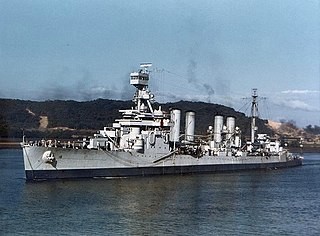
USS Concord (CL-10) was an Omaha-class light cruiser, originally classified as a scout cruiser, of the United States Navy. She was the fourth Navy ship named for the town of Concord, Massachusetts, the site of the first battle of the American Revolution. She spent the first nine years of her career in the Atlantic as part of the Scouting Force. Concord transferred to the Pacific in 1932 and spent the rest of her career, except for the winter of 1938–1939, stationed there. Her home port moved to Pearl Harbor in April 1940, but escaped the attack on Pearl Harbor because she was in San Diego for an overhaul.
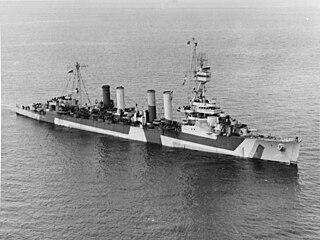
USS Detroit (CL-8) was an Omaha-class light cruiser, originally classified as a scout cruiser, of the United States Navy. She was the fourth Navy ship named for the city of Detroit, Michigan. She spent her first eight years as part of the Scouting Fleet either in the Atlantic or Mediterranean. Her first duty was to assist in the USAAS's first aerial circumnavigation of the world in 1924 and transported the United States Secretary of State Frank B. Kellogg, in 1927, from Ireland to France for the negotiations that led to the signing of the Kellogg-Briand Pact. In 1931 she joined the Battle Force, where her home port was San Diego until moving to Pearl Harbor in 1941. Detroit was moored next to her sister Raleigh when the Japanese attacked on the morning of 7 December 1941.

USS Trenton (CL-11) was an Omaha-class light cruiser, originally classified as a scout cruiser, of the United States Navy. She was the second Navy ship named for the city of Trenton, New Jersey. She spent most of her pre-war career moving between the Atlantic and the Pacific. Trenton joined the Special Service Squadron in 1934, for a good-will tour of Latin America. In May 1939, she would join Squadron 40-T in protecting American interests during the Spanish Civil War and not return to the US until July 1940, when she carried the royal family of Luxembourg, fleeing from the Nazi occupation of their country.
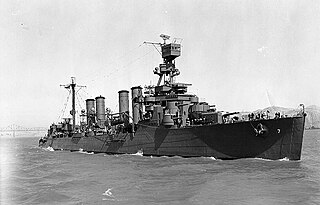
USS Raleigh (CL-7) was the fourth Omaha-class light cruiser, originally classified as a scout cruiser, built for the United States Navy. She was the third Navy ship named for the city of Raleigh, North Carolina. The first being Raleigh, a 32–gun frigate built in 1776, during the American Revolution, and captured by the British in 1778. The second was the protected cruiser Raleigh, commissioned in 1894, and decommissioned in 1919.

USS Richmond (CL-9) was an Omaha-class light cruiser, originally classified as a scout cruiser, of the United States Navy. She was the third Navy ship named for the city of Richmond, Virginia.

The Omaha-class cruisers were a class of light cruisers built for the United States Navy. They were the oldest class of cruiser still in active service with the Navy at the outbreak of World War II, being an immediate post-World War I design.

The Tennessee-class cruisers were four armored cruisers built for the United States Navy between 1903 and 1906. Their main armament of four 10-inch (254 mm) guns in twin turrets was the heaviest carried by any American armored cruiser. Their armor was thinner than that of the six Pennsylvanias which immediately preceded them, a controversial but inevitable decision due to newly imposed congressional restraints on tonnage for armored cruisers and the need for them to be able to steam at 22 knots. However, the fact their armor covered a wider area of the ship than in the Pennsylvanias and their increased firepower caused them to be seen by the Navy as an improvement.

SMS Kaiserin und Königin Maria Theresia was an armored cruiser used by the imperial Austro-Hungarian Navy from 1895 to 1917; she was the first ship of that type built by the Austro-Hungarian Navy. The ship was a unique design, built by the Stabilimento Tecnico Triestino shipyard in Trieste; she was laid down in July 1891, launched in April 1893, and completed in November 1894. Armed with a main battery of two 24-centimeter (9.4 in) guns and eight 15 cm (5.9 in) guns, the ship provided the basis for two subsequent armored cruiser designs for the Austro-Hungarian Navy.

Admiral Makarov was the second of the four Bayan-class armoured cruisers built for the Imperial Russian Navy during the mid-1900s. While initially assigned to the Baltic Fleet, the ship was detached to the Mediterranean several times before the start of World War I in 1914. She was modified to lay mines shortly after the war began. Admiral Makarov laid mines herself during the war and provided cover for other ships laying minefields. The ship fought several inconclusive battles with German ships during the war, including the Battle of Åland Islands in mid–1915. She also defended Moon Sound during the German invasion of the Estonian islands in late 1917. Admiral Makarov was decommissioned in 1918 and sold for scrap in 1922.
